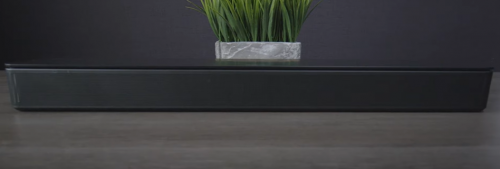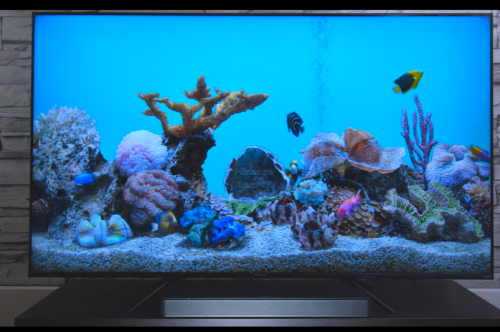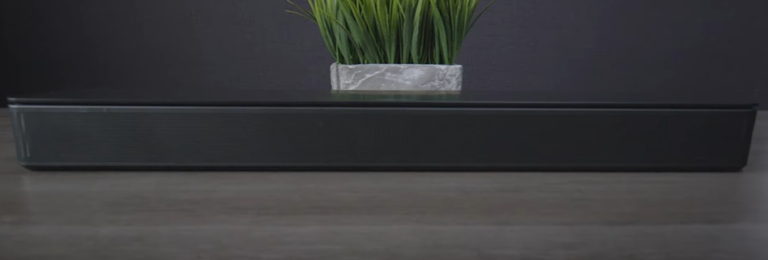It’s true that Bose is a leading brand in the audio industry, but just picking any soundbar from their lineup can inadvertently make you buy something that’s below your standards. Here, we’re comparing two of their best products—the Bose Solo 5 and Bose TV Speaker.
Bose Solo 5 or Bose TV Speaker?
- Bluetooth connectivity
- Dialogue mode
- Single connection to TV
- Universal remote control
- Flexible placement
- Compact soundbar, only 2” tall
- Two full-range drivers
- Dialogue mode
- HDMI-CEC technology
- Simple soundbar setup
Features Comparison:
Bose Solo 5 Soundbar Versus Bose TV Speaker System
Upgrading the sound of your TV speakers isn’t hard with these options from Bose.
Main Difference
There are actually a few differences between the Bose Solo 5 and the Bose TV speaker, but the most important one is the sound quality. The Bose TV speaker is a newer version of the Solo 5, so it’s a no-brainer that it provides better audio, but more on this later.
Another distinct difference is the range of connectivity options. Like most popular soundbars today, the Bose TV Speaker is equipped with optical audio input, a 3.5mm aux input, Bluetooth, and HDMI ARC. Solo 5 has these too, except for HDMI, which gives another point to Bose TV Speaker.
Without HDMI ports, the Bose Solo 5 won’t be able to support advanced decoding technologies. So even if the movie you’re watching is capable of DTS, the sound will be downplayed, losing some of its quality. However, the sound quality remains fairly well-balanced even without HDMI.
Finally, the ability to add new speakers is a major distinction between Bose Solo 5 vs Bose TV speaker. The Solo 5 is built to stand alone, so there’s no option for you to add new speakers to this soundbar.
On the other hand, the Bose TV speaker can be connected to a wireless subwoofer or even rear modules. As such, you can better achieve surround sound with this model if you want a more immersive sound quality.
Still, if you’re just looking for a budget soundbar and you don’t intend to add a whole home theater system, the Solo 5 is a great option.
Sound Quality
As mentioned, the Bose TV Speaker has an obvious advantage over the Bose Solo 5 in terms of sound quality. This is reflected in the multiple tests we’ve done as well, so let’s get into the nitty-gritty of why that is.
First off, Bose TV Speaker has two custom all-band drivers and one central tweeter. Bose Solo 5, on the other hand, only has left and right speakers with no center driver. This results in a downplayed audio because the two drivers are used to produce sound in the center.
As a result, the sound becomes a bit muffled compared to a clearer output when you have a center speaker. When we played music and movies on the Solo 5 and compared the quality with the TV Speaker, the latter sounded much clearer and the bass was more pronounced.
The lack of HDMI input in the Solo 5 also puts it at a disadvantage. While the setup of the TV Speaker and the Solo 5 still takes one connection, the HDMI of the TV Speaker is a qualified edge.
With HDMI, the Bose TV Speaker provides better quality sound since it can pass on higher-resolution audio, especially since some audio formats can’t be relayed through an optical connection.
One similarity between these two Bose products is the dialogue mode and bass adjustments. In both models, you can use the dialogue mode to enhance the voices in news, movies, and TV shows. If you want to boost the bass, you can adjust the levels too by simply pressing the “Bass” button on the remote.
When we compared the raw bass between the Bose Solo 5 and the Bose TV Speaker, we noticed a distinct difference as well. The bass from the TV Speaker had more depth and rumble, which is a noticeable improvement over the bass from the Solo 5.
However, that’s not to say that the Solo 5 produces poor bass. For a soundbar without a subwoofer, the Solo 5 is actually a pretty impressive unit. The bass is still rich and deep, and there’s very minimal distortion when the volume is turned all the way up.
Still, in an overall evaluation between the Bose TV Speaker vs Bose Solo 5, the TV Speaker is the winner when it comes to sound quality.
TV Compatibility
Both Bose Solo 5 and Bose TV Speaker are compatible with most HDTVs that have an optical audio output. The only difference is that the TV Speaker has HDMI, so it’s also compatible with TVs that have HDMI-ARC connectivity [1].
In this aspect, the HDMI compatibility of the Bose TV Speaker serves an advantage as well. Setup is so much easier and it’s a preferred connectivity option among many users too.
Bluetooth Range Performance
The Bose TV Speaker has all the advantages at this point. But when it comes to Bluetooth range, the Bose Solo 5 has a slight upper hand.
You can have a stable Bluetooth connection with your Solo 5 of up to 33 feet. As for the Bose TV Speaker, you can only have a solid link for up to 30 feet.
These claims proved to be true when we tried them during testing. At a distance of 32 feet, our mobile device stayed connected to the Bose Solo 5, and there was still no delay or loss with the audio. On the other hand, the Bose TV Speaker got disconnected at the same distance.
Overall Winner: Bose TV Speaker
After multiple comparison tests by our sound experts, Bose TV Speaker’s impressive audio quality has proven better than the Solo 5. Its superior connectivity and compatibility makes it highly convenient and more user-friendly as well.
Considering these significant advantages, we declare Bose TV Speaker as the winner of the Bose Solo 5 vs Bose TV Speaker battle.
Both devices come at affordable prices, but do you want to see more options? See our list of soundbars under five hundred for more models worth purchasing.





